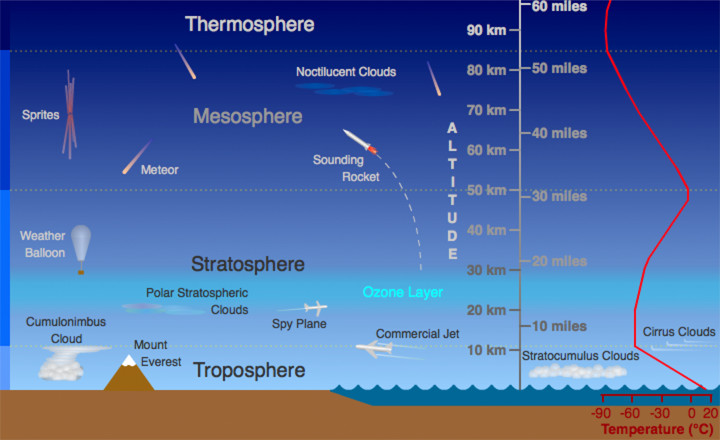Causes: Ozone O3
The ozone hole over Antarctica, 2020 – Image: NASA Earth Observatory
Causes
- A brief history of climate change: who knew what, when
- What causes climate change?
- Would the climate be warming without humans?
- Is it just a cycle? (Earth’s wobbly orbit)
- Sunspots & solar activity
- Land use: agriculture & cities
- Volcanoes
- Ocean currents
- Black carbon & ash
- Hydrogen
- Greenhouse gases & how they work
- – Carbon dioxide & the carbon cycle
- – Methane: biogenic (mostly cows) & ‘natural’ gas
- – Nitrous oxide
- – Clouds & water vapour
- – Ozone
- – Man-made industrial chemicals
- – Aerosol pollution
- How to start an Ice Age!
- What’s in a name?
Other sections
Home > Climate wiki > What causes climate change? > Greenhouse gases > Ozone
Ozone O3
Summary
- Ozone in the lower atmosphere (troposphere)(Fig. 1) is a greenhouse gas that absorbs some infrared energy from Earth, re-radiating it into the atmosphere. Due entirely to the way it chemically interacts with man-made emissions—including methane, nitrous oxide, and carbon monoxide—because ozone is a short-lived gas, its concentration varies enormously in different places, times, and seasons.
- Ozone in the upper atmosphere (stratosphere)(Fig. 1), protects the DNA of plants and animals from harmful solar radiation. Without it, life on the surface of the Earth wouldn’t be able to exist. The Montreal Protocol aims to protect the ozone layer by phasing out the use of man-made chemicals (CFCs) that deplete it. This has helped prevent large quantities of carbon dioxide in plants and soils from being released into the atmosphere, which would have resulted in even more warming:
“The avoided ultraviolet radiation and climate change also have co-benefits for plants and their capacity to store carbon through photosynthesis…we estimate that there could have been 325–690 billion tonnes less carbon held in plants and soils by the end of this century (2080–2099) without the Montreal Protocol (as compared to climate projections with controls on ozone-depleting substances).” – Young et al, 2021
“Ozone depletion is not only a serious health threat but can also affect the climate. Atmospheric chemistry models reveal that springtime Arctic ozone depletion can have major consequences for the seasonal climate in the Northern Hemisphere, including warming over Eurasia and drying across central Europe.” – Nature Geoscience Article 07 Jul 2022
- This underscores the point that greenhouse gases are not inherently ‘bad’. Rather, that human activities have and continue to change the balance of gases in the atmosphere, causing a complex array of problems for life on Earth.
- Unfortunately, in spite of the international Montreal Agreement to stop using ozone-depleting gasses that destroy ozone on the troposhere, the hole in the ozone layer over the Arctic grew to a record size in 2020 (top image).
“The South-Eastern Australian bushfires between 2019 to 2020 released smoke particles into the Earth’s upper atmosphere that contributed to the highest recorded temperature in the lower stratosphere since the early 1990s, and could have extended the lifetime of the Antarctic ozone hole.” – Damany- Pierce et al, 2022
“Ongoing emissions of CFCs may negate some of the benefits gained under the Montreal Protocol if they continue to rise. In addition, the climate impact of the emissions of these CFCs needs to be considered, as their 2020 emissions are equivalent to 47 ± 5 TgCO2.” – Western et al, 2023
Causes
- A brief history of climate change: who knew what, when
- What causes climate change?
- Would the climate be warming without humans?
- Is it just a cycle? (Earth’s wobbly orbit)
- Sunspots & solar activity
- Land use: agriculture & cities
- Volcanoes
- Ocean currents
- Black carbon & ash
- Hydrogen
- Greenhouse gases & how they work
- – Carbon dioxide & the carbon cycle
- – Methane: biogenic (mostly cows) & ‘natural’ gas
- – Nitrous oxide
- – Clouds & water vapour
- – Ozone
- – Man-made industrial chemicals
- – Aerosol pollution
- How to start an Ice Age!
- What’s in a name?
Other sections
Home > Climate wiki > What causes climate change? > Greenhouse gases > Ozone
Summary
- Ozone in the lower atmosphere (troposphere)(Fig. 1) is a greenhouse gas that absorbs some infrared energy from Earth, re-radiating it into the atmosphere. Due entirely to the way it chemically interacts with man-made emissions—including methane, nitrous oxide, and carbon monoxide—because ozone is a short-lived gas, its concentration varies enormously in different places, times, and seasons.
- Ozone in the upper atmosphere (stratosphere)(Fig. 1), protects the DNA of plants and animals from harmful solar radiation. Without it, life on the surface of the Earth wouldn’t be able to exist. The Montreal Protocol aims to protect the ozone layer by phasing out the use of man-made chemicals (CFCs) that deplete it. This has helped prevent large quantities of carbon dioxide in plants and soils from being released into the atmosphere, which would have resulted in even more warming:
“The avoided ultraviolet radiation and climate change also have co-benefits for plants and their capacity to store carbon through photosynthesis…we estimate that there could have been 325–690 billion tonnes less carbon held in plants and soils by the end of this century (2080–2099) without the Montreal Protocol (as compared to climate projections with controls on ozone-depleting substances).” – Young et al, 2021
“Ozone depletion is not only a serious health threat but can also affect the climate. Atmospheric chemistry models reveal that springtime Arctic ozone depletion can have major consequences for the seasonal climate in the Northern Hemisphere, including warming over Eurasia and drying across central Europe.” – Nature Geoscience Article 07 Jul 2022
- This underscores the point that greenhouse gases are not inherently ‘bad’. Rather, that human activities have and continue to change the balance of gases in the atmosphere, causing a complex array of problems for life on Earth.
- Unfortunately, in spite of the international Montreal Agreement to stop using ozone-depleting gasses that destroy ozone on the troposhere, the hole in the ozone layer over the Arctic grew to a record size in 2020 (top image).
“The South-Eastern Australian bushfires between 2019 to 2020 released smoke particles into the Earth’s upper atmosphere that contributed to the highest recorded temperature in the lower stratosphere since the early 1990s, and could have extended the lifetime of the Antarctic ozone hole.” – Damany- Pierce et al, 2022
“Ozone is present in two different areas of the atmosphere and plays two different roles. It is produced naturally in the outer layers of the atmosphere (the stratosphere) very high above earth. This stratospheric ozone helps protect the planet from the Sun’s ultraviolet rays which can damage our skin and health. This ozone is typically known as the ozone layer.
“Although ozone is vital in the stratosphere, here at the Earth’s surface it is a pollutant which can damage our health and the environment.
“At the Earth’s surface, ozone is not directly emitted but is formed by reactions of other pollutants such as nitrogen oxides and volatile organic compounds (VOCs), and sunlight. This is known as a photochemical reaction and often produces photochemical smog.
“The primary pollutants are produced mainly from motor-vehicle emissions and other combustion sources, and industrial and domestic use of solvents and coatings.
“Auckland, Hamilton and Christchurch have the highest potential for ozone pollution.” – NZ Ministry for the Environment
More information
-

The term ‘climate forcing’ comes from ‘radiative forcing’ or RF, which is the difference between the amount of solar energy reaching Earth’s atmosphere and the amount that escapes. If more solar energy escapes than arrives, the planet cools. Conversely, if less energy escapes than gets in, the planet warms.
Click here to learn about the main forcings and how they work (links to a page on this site).
-
- 2023: Western et al; Global increase of ozone-depleting chlorofluorocarbons from 2010 to 2020, Nature Geoscience 16, pp309–313
- 2022: Liu et al; Stratospheric ozone depletion and tropospheric ozone increases drive Southern Ocean interior warming. Nature Climate Change 12 pp365-372
- 2022: Damany-Pierce et al; Australian wildfires cause the largest stratospheric warming since Pinatubo and extends the lifetime of the Antarctic ozone hole, Nature Scientific Reports 12 | 12665
- 2022: Ozone depletion over the Arctic affects spring climate in the Northern Hemisphere – Nature Geoscience Article 07 July 2022
- 2022: Friedel et al, Springtime arctic ozone depletion forces northern hemisphere climate anomalies, Nature Geoscience 15 pp541-547
- 2022: Ivatt et al, Suppression of surface ozone by an aerosol-inhibited photochemical ozone regime. Nature Geoscience 15 pp536-540 (open access)
- 2022: Seviour; Good ozone, bad ozone and the Southern Ocean. Nature Climate Change 12 pp316 -317
- Ministry for the Environment: New Zealand’s Greenhouse Gas Inventory 1990–2017 Vol 1; Chapters 1-15
- Ministry for the Environment: New Zealand’s Greenhouse Gas Inventory 1990–2017: graphic
- Ministry for the Environment: 2019 Measuring Emissions: A Guide for Organisations
- Ministry for the Environment: 2019 Measuring Emissions: A Guide for Organisations. 2019 Summary of Emission Factors
- Ministry for the Environment: New Zealand’s Greenhouse Gas Inventory
- NOAA: Global Monitoring Laboratory Earth System Research Laboratories
- UCAR Center for Science Education: The troposhere
- 2021: Young et al., The Montreal Protocol protects the terrestrial carbon sink, Nature 596, pp384–388
- 2021 Vollmer et al; Unexpected nascent atmospheric emissions of three ozone-depleting hydrochlorofluorocarbons, PNAS 118 (5)
- 2020 Polvani et al; Substantial twentieth-century Arctic warming caused by ozone-depleting substances Nature Climate Change 10, 130-133
- 2020 WMO (World Meteorological Organization): Arctic ozone depletion reached record level
- 2019 IPCC: Refinement to the 2006 IPCC Guidelines for National Greenhouse Gas Inventories
- 2018 IPCC: Chapter 4, Atmospheric Chemistry and Greenhouse Gases
- 2013 IPPC: Chapter 8: Anthropogenic and Natural Radiative Forcing in: Climate Change 2013: The Physical Science Basis. Contribution of Working Group I to the Fifth Assessment Report of the Intergovernmental Panel on Climate Change
-
- 2023: Western et al; Global increase of ozone-depleting chlorofluorocarbons from 2010 to 2020, Nature Geoscience 16, pp309–313
- 2022: Liu et al; Stratospheric ozone depletion and tropospheric ozone increases drive Southern Ocean interior warming. Nature Climate Change 12 pp365-372
- 2022: Damany-Pierce et al; Australian wildfires cause the largest stratospheric warming since Pinatubo and extends the lifetime of the Antarctic ozone hole, Nature Scientific Reports 12 | 12665
- 2022: Seviour; Good ozone, bad ozone and the Southern Ocean. Nature Climate Change 12 pp316 -317
- 2022: Ozone depletion over the Arctic affects spring climate in the Northern Hemisphere – Nature Geoscience Article 07 July 2022
- 2022: Friedel et al, Springtime arctic ozone depletion forces northern hemisphere climate anomalies, Nature Geoscience 15 pp541-547
- 2022: Ivatt et al, Suppression of surface ozone by an aerosol-inhibited photochemical ozone regime. Nature Geoscience 15 pp536-540 (open access)
- Ministry for the Environment: New Zealand’s Greenhouse Gas Inventory 1990–2017 Vol 1; Chapters 1-15
- Ministry for the Environment: New Zealand’s Greenhouse Gas Inventory 1990–2017: graphic
- Ministry for the Environment: 2019 Measuring Emissions: A Guide for Organisations
- Ministry for the Environment: 2019 Measuring Emissions: A Guide for Organisations. 2019 Summary of Emission Factors
- Ministry for the Environment: New Zealand’s Greenhouse Gas Inventory
- NOAA: Global Monitoring Laboratory Earth System Research Laboratories
- UCAR Center for Science Education: The troposhere
- 2021: Young et al., The Montreal Protocol protects the terrestrial carbon sink, Nature 596, pp384–388
- 2021 Vollmer et al; Unexpected nascent atmospheric emissions of three ozone-depleting hydrochlorofluorocarbons, PNAS 118 (5)
- 2020 Polvani et al; Substantial twentieth-century Arctic warming caused by ozone-depleting substances Nature Climate Change 10, 130-133
- 2020 WMO (World Meteorological Organization): Arctic ozone depletion reached record level
- 2019 IPCC: Refinement to the 2006 IPCC Guidelines for National Greenhouse Gas Inventories
- 2018 IPCC: Chapter 4, Atmospheric Chemistry and Greenhouse Gases
- 2013 IPPC: Chapter 8: Anthropogenic and Natural Radiative Forcing in: Climate Change 2013: The Physical Science Basis. Contribution of Working Group I to the Fifth Assessment Report of the Intergovernmental Panel on Climate Change


